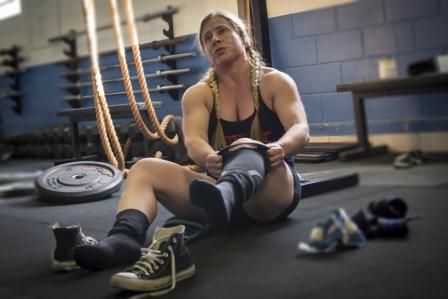Introduction
(Originally published by me at https://www.elitefts.com/education/how-research-can-help-you-manage-detraining-and-retraining/ )
Yesterday I did many sets of few reps of empty bar snatches. After that, some drop snatches and presses. I got tired, my breathing was labored but I was happy: I’ve been ill during the past four months and it felt good to move. I barely managed to maintain a low volume and intensity in strength training for two months, insisted on a little treadmill walking to avoid insanity for another month and then nothing. I was basically slithering around the house under heavy medication, mildly stoned and weak. My strength and my conditioning decreased dramatically.
What happened to my bone metabolism? The quality and functioning of my skeletal muscles? My inflammatory indicators? My body composition (lean and fat mass)? They were all negatively affected. This is what we call “detraining”.
If one is an athlete, after a period of detraining there is usually a period of retraining. “Retraining” is the set of adaptive responses to resuming training after a period of training cessation. The more experienced the athlete, the faster the retraining period up to performance levels before detraining.
There is not a lot of research about detraining and retraining. A Pubmed search with the title search term “detraining” resulted in 390 items (all time). The same search with the term “retraining” resulted in 915 items (all time). Most “retraining” titled articles are not related to sports.
My goals with this article are:
- To assess the state of the art on the present scientific knowledge about training and retraining;
- Whenever possible, to point out what health care professionals, coaches, and athletes might expect in detraining and retraining.
It might not be much but there’s a reason for this choice: detraining and retraining are both scary. Detraining is often a process that follows injury or illness, both negative experiences with frequently unknown consequences over an athlete’s performance. Retraining is something athletes usually engage in eagerly and with great expectation. Also, with great anxiety.
A little bit of knowledge can go a long way in managing this kind of stress.
What is Detraining

Detraining is not just to “stop training for a while”. Detraining is the set of physiological responses to the cessation of training. It frequently results in loss of performance. The exception is when detraining happens after a period of overtraining and burnout and performance gains are observed in the absence of retraining.
Detraining can be a serious process. It can be even more serious for high performance and elite athletes, even at a young age and for short periods. Sung et al (2017) demonstrated that a two-month detraining period resulted in adverse effects on early atherogenic dyslipidemia development, progressing insulin resistance, low-grade inflammation, and visceral adiposity in young elite taekwondo athletes.
Another study on elite male soccer players examined their bone metabolism (Koundourakis et al 2018). A six-week supervised detraining was sufficient to cause suppression of bone-formation rate and a parallel induction of bone resorption.
Several studies suggest oxidative capacity decrease after detraining (Liao et al 2016). The decrease in energy metabolism enzymes and ATP production led to the hypothesis of decreased mitochondrial content in the muscle fiber (Chi et al 1983, Staron et al 1981, Wibom et al 1992).
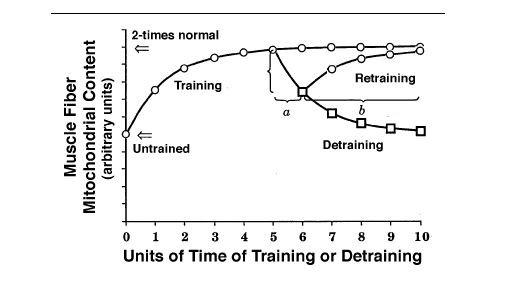
Kirshner’s interpretation of Wibom et al (1992)
The claimed mitochondrial content effect was never measured and one case study about a detrained powerlifter suggested exactly the opposite (Staron et al 1981): the authors’ hypothesis was that the mitochondrial content of the detrained fiber remains constant (for a strength-trained muscle), but as the volume of the fiber decreases, the mitochondrial volume percent increases.
The cause, type of sport, age and period of detraining are important factors concerning observed physiological results. More than one study shows that a four-week detraining period may have negligible effect on performance (McMahon et al 2019, Kraemer et al 2002). All other things being equal, there is a dose-response to time in strength loss (Bosquet et al 2013). This hypothesis was also confirmed by Vassilis and collaborators (2019) with young soccer players submitted to a four-week period of detraining, with no measurable effect on isokinetic strength on their lower limbs.
What is Retraining

Trained individuals, limbs and even muscles respond better and faster than “naïve” ones (previously untrained). This had been observed by athletes and coaches since time immemorial. A few decades ago, it was termed “muscle memory”. Experimental results from animal models show an increased response from pre-trained versus naïve individuals even for short training periods and long detraining ones (Lee et al 2016).
Between 2010-13, the scientific community embraced the cellular explanation for the “muscle memory” phenomenon (Gundersen 2016):
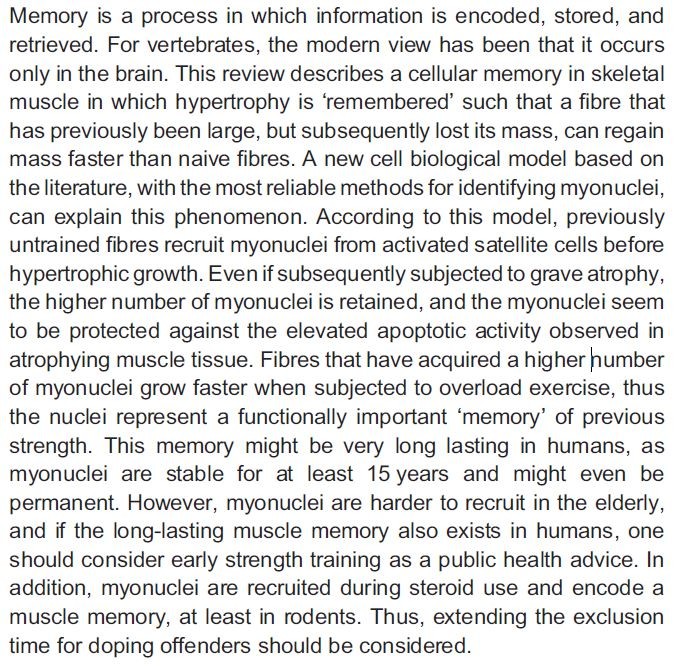
The mystery seemed to have been solved but we probably celebrated too early. Evidence suggests that the elevated myonuclear density acquired during training is lost during detraining (Dungan et al 2019).
Psilander and collaborators (2019), studying humans, observed a 20% strength increase in the trained group versus a 5% increase in the untrained group in the first training period, comparable to the muscle thickness (proxy to hypertrophy) response, although after the detraining and retraining, no differences in myonuclei density were observed.
We still agree that “muscle memory” exists but it doesn’t seem to be mediated by myonuclei density as previously thought (Murach et al 2019). New studies on epigenetic phenomena associated with skeletal muscle hypertrophy/atrophy are promising and offer plausible alternative models (Seaborne et al 2018).
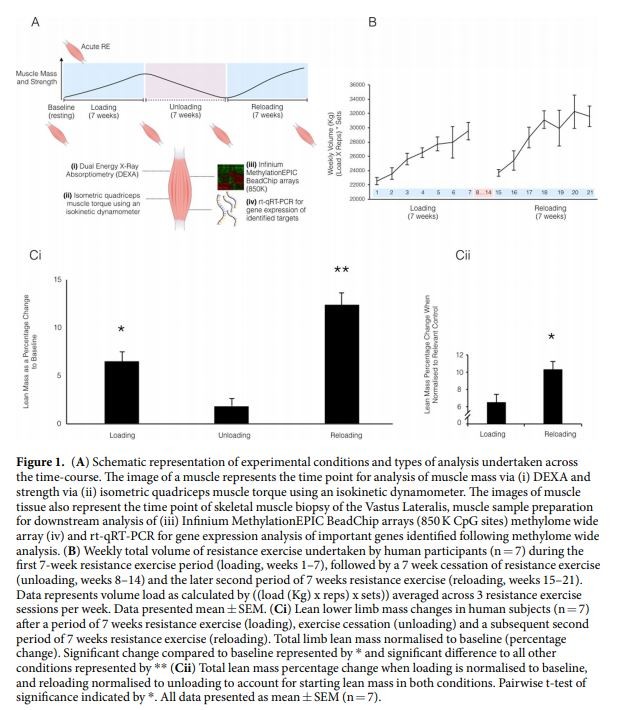

Disease, Injury, and Planned Detraining
As is probably clear by now, the reason why detraining happened in any specific case is an important factor in how serious the health consequences acquired during detraining are and how retraining takes place. The main reasons for training cessation among athletes are injury and illness (Timpka 2014). There are two measures that matter in sports injury and illness epidemiology: incidence and burden, expressed as the number of lost days, hours or competitions.
Disease, Injury, and Their Burden

Bahr and collaborators (2018) have argued that we must shift our focus from injury and illness incidence to burden because both individually and institutionally, that is what matters. If a low burden injury has a high incidence, it affects the athlete, the team and the sponsors much less than high burden injuries with a lower incidence, but enough to damage the patient’s athletic life, the team prospects, and the sponsors’ investments.
The picture below illustrates this point: while lower leg contusion has a high incidence on football, it has a low burden. ACL tears, on the other hand, have a high burden.
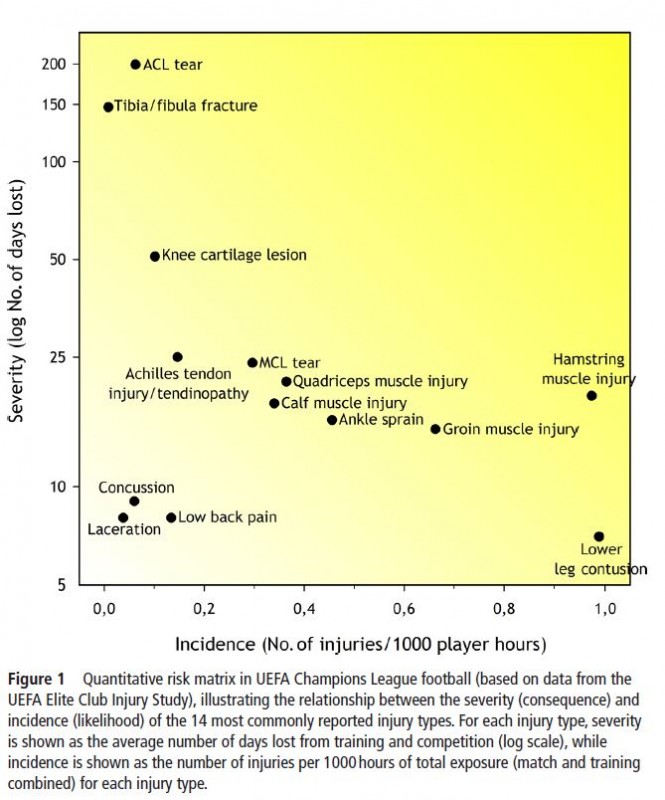
From Bahr et al (2018)
Different sports have different incidence and burden rates for injury and disease. It is important to observe that incidence and burden are very different for each type of injury. Acute injuries can have a lower incidence and higher burden or vice-versa.
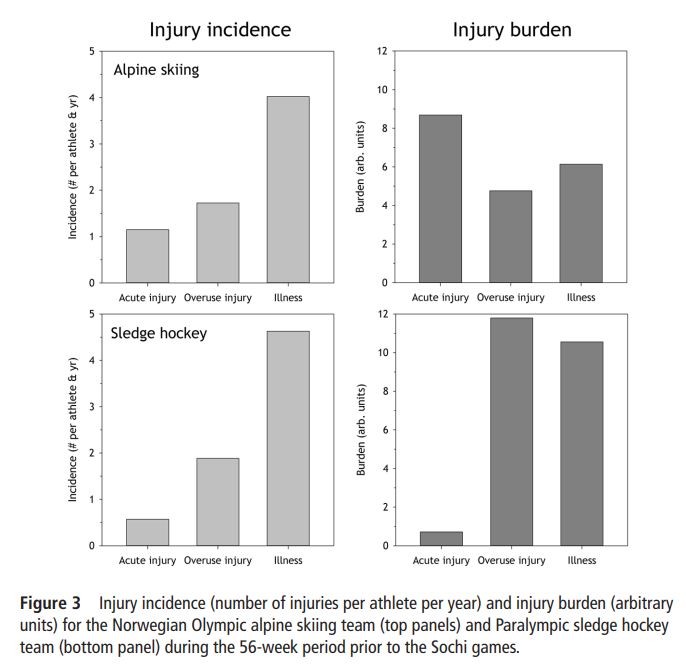
From Bahr et al (2018)
Burden and incidence can be different for the training period and competition. Most coaches and athletes are painfully aware of the reality shown in the picture below: while injury incidence is lower in the final phase, when it happens, it tends to be worse and cause a higher number of lost days, and, frequently, lost competitions.
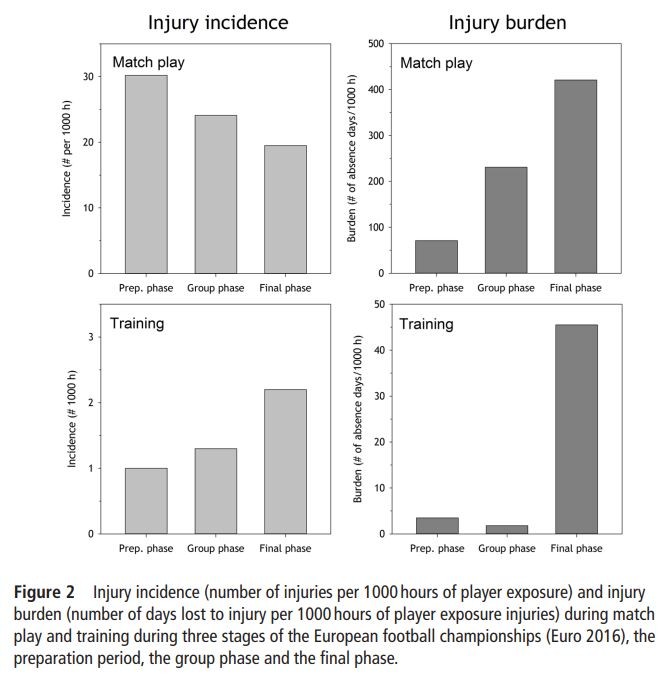
The number of lost days (and detraining) among elite athletes can represent a good part of the competitive year. A study conducted in Ireland showed that the average athlete suffered the effects of sports injury for 52 days in a year. More time was lost through overuse injuries than acute injuries. The injury rate per 10,000 hours of participation was lowest in noncontact and explosive sports and highest in contact sports. However, when expressed in terms of days lost per 1000 hours of participation, endurance sports had the lowest burden of time loss and explosive sports the highest (Watson 1993). In terms of the amount of time lost due to injury, elite gymnasts spent 20.2% of the year’s training time at less than full capacity, compared with 13.9% for the nonelite gymnasts. (Kolt et al 1995). In a study with collegiate female athletes, during the 12 recorded months, lost-time injuries occurred in 31.4% of the athletes (Walbright 2017). Among Brazilian Jiu-Jitsu athletes, players missed an average of 35.9 ± 60.1 days of practice due to BJJ-related injury in 12 months (Usuki et al 2017).
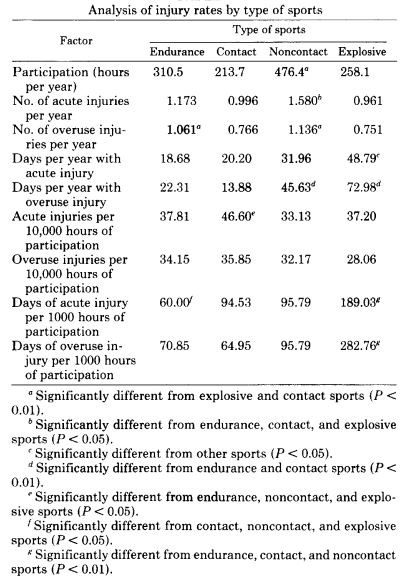
From Watson 1993.
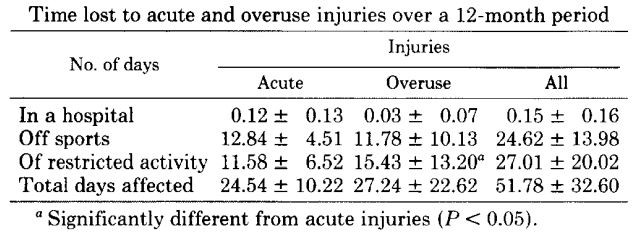
From Watson 1993.
Planned Detraining
Planned detraining may not be detraining proper or it may be a training strategy when competing physiological adaptations are involved. This is known as “concurrent training and retraining” and is mostly applied to track and field and team sports (Sousa et al 2019).

The exact mechanisms involved are unknown but the strategy has been used intuitively and successfully by powerlifters since there is any record of programming. Recent studies simply confirm that a period of training cessation of a little less than a week is, on average, optimal (Pritchard et al 2017, Pritchard et al 2016).
Much research is needed to start to understand the nature of the beneficial short-term training cessation. A few interesting molecular studies have been conducted and we might have a better understanding of the involved phenomena in a couple of years (Ogasawara et al 2013).
Takeaways

References
- Bahr, Roald, Benjamin Clarsen, and Jan Ekstrand. “Why we should focus on the burden of injuries and illnesses, not just their incidence.” (2018): 1018-1021.
- Bosquet, L., N. Berryman, O. Dupuy, S. Mekary, D. Arvisais, L. Bherer, and I. Mujika. “Effect of training cessation on muscular performance: A meta‐analysis.” Scandinavian journal of medicine & science in sports 23, no. 3 (2013): e140-e149.
- Bosquet, L., N. Berryman, O. Dupuy, S. Mekary, D. Arvisais, L. Bherer, and I. Mujika. “Effect of training cessation on muscular performance: A meta‐analysis.” Scandinavian journal of medicine & science in sports 23, no. 3 (2013): e140-e149.
- Chi, M. M., C. S. Hintz, Edward F. Coyle, W. H. Martin 3rd, J. L. Ivy, PATTI M. Nemeth, J. O. Holloszy, and Oliver H. Lowry. “Effects of detraining on enzymes of energy metabolism in individual human muscle fibers.” American Journal of Physiology-Cell Physiology 244, no. 3 (1983): C276-C287.
- Dungan, Cory M., Kevin A. Murach, Kaitlyn K. Frick, Savannah R. Jones, Samuel E. Crow, Davis A. Englund, Ivan J. Vechetti Jr et al. “Elevated myonuclear density during skeletal muscle hypertrophy in response to training is reversed during detraining.” American Journal of Physiology-Cell Physiology 316, no. 5 (2019): C649-C654.
- Gundersen, Kristian. “Muscle memory and a new cellular model for muscle atrophy and hypertrophy.” Journal of Experimental Biology 219, no. 2 (2016): 235-242.
- Kolt, Gregory S., and Robert J. Kirkby. “Epidemiology of injury in Australian female gymnasts.” Research in Sports Medicine: An International Journal 6, no. 3 (1995): 223-231.
- Koundourakis, Nikolaos E., Nikolaos Androulakis, Eirini Dermitzaki, Maria Venihaki, and Andrew N. Margioris. “Effect of a 6-week supervised detraining period on bone metabolism markers and their association with ergometrics and components of the hypothalamic–pituitary–gonadal (HPG) axis in professional male soccer players.” Journal of bone and mineral metabolism 37, no. 3 (2019): 512-519.
- Kraemer, WILLIAM J., L. PERRY Koziris, NICHOLAS A. Ratamess, K. Hakkinen, N. TRAVIS TRIPLETT-McBRIDE, ANDREW C. Fry, SCOTT E. Gordon et al. “Detraining produces minimal changes in physical performance and hormonal variables in recreationally strength-trained men.” Journal of Strength and Conditioning Research 16, no. 3 (2002): 373-382.
- Lee, Sukho, Kwang-Seok Hong, and Kijeong Kim. “Effect of previous strength training episode and retraining on facilitation of skeletal muscle hypertrophy and contractile properties after long-term detraining in rats.” Journal of exercise rehabilitation 12, no. 2 (2016): 79.
- Liao, Yi-Hung, Yu-Chi Sung, Chun-Chung Chou, and Chung-Yu Chen. “Eight-week training cessation suppresses physiological stress but rapidly impairs health metabolic profiles and aerobic capacity in elite taekwondo athletes.” PloS one 11, no. 7 (2016): e0160167.
- McMahon, Gerard, Christopher I. Morse, Keith Winwood, Adrian Burden, and Gladys L. Onambélé. “Circulating Tumor Necrosis Factor Alpha May Modulate the Short-Term Detraining Induced Muscle Mass Loss Following Prolonged Resistance Training.” Frontiers in physiology 10 (2019).
- Murach, Kevin A., Cory M. Dungan, Esther E. Dupont-Versteegden, John J. McCarthy, and Charlotte A. Peterson. “Muscle Memory” Not Mediated By Myonuclear Number?: Secondary Analysis of Human Detraining Data.” Journal of Applied Physiology (2019).
- Ogasawara, Riki, Koji Kobayashi, Arata Tsutaki, Kihyuk Lee, Takashi Abe, Satoshi Fujita, Koichi Nakazato, and Naokata Ishii. “mTOR signaling response to resistance exercise is altered by chronic resistance training and detraining in skeletal muscle.” Journal of applied physiology 114, no. 7 (2013): 934-940.
- Pritchard, Hayden J., David A. Tod, Matthew J. Barnes, Justin W. Keogh, and Michael R. McGuigan. “Tapering practices of New Zealand’s elite raw powerlifters.” Journal of strength and conditioning research 30, no. 7 (2016): 1796-1804.
- Pritchard, Hayden J., Matthew J. Barnes, Robin JC Stewart, Justin WL Keogh, and Michael R. McGuigan. “Short term training cessation as a method of tapering to improve maximal strength Training cessation as a method of tapering for strength.” The Journal of Strength & Conditioning Research (2017).
- Psilander, Niklas, Einar Eftestøl, Kristoffer Toldnes Cumming, Inga Juvkam, Maria M. Ekblom, Kerstin Sunding, Mathias Wernbom et al. “Effects of training, detraining, and retraining on strength, hypertrophy, and myonuclear number in human skeletal muscle.” Journal of Applied Physiology 126, no. 6 (2019): 1636-1645.
- Seaborne, Robert A., Juliette Strauss, Matthew Cocks, Sam Shepherd, Thomas D. O’Brien, Ken A. van Someren, Phillip G. Bell et al. “Human skeletal muscle possesses an epigenetic memory of hypertrophy.” Scientific Reports 8, no. 1 (2018): 1898.
- Sousa, António C., Henrique Pereira Neiva, Mikel Izquierdo, Eduardo Lusa Cadore, Ana R. Alves, and Daniel Almeida Marinho. “Concurrent Training and Detraining: brief Review on the Effect of Exercise Intensities.” International journal of sports medicine (2019).
- Staron, Robert S., Fredrick C. Hagerman, and Robert S. Hikida. “The effects of detraining on an elite powerlifter: a case study.” Journal of the neurological sciences 51, no. 2 (1981): 247-257.
- Sung, Yu-Chi, Yi-Hung Liao, Chung-Yu Chen, Yu-Liang Chen, and Chun-Chung Chou. “Acute changes in blood lipid profiles and metabolic risk factors in collegiate elite taekwondo athletes after short-term de-training: a prospective insight for athletic health management.” Lipids in health and disease 16, no. 1 (2017): 143.
- Timpka, Toomas, Juan-Manuel Alonso, Jenny Jacobsson, Astrid Junge, Pedro Branco, Ben Clarsen, Jan Kowalski et al. “Injury and illness definitions and data collection procedures for use in epidemiological studies in Athletics (track and field): consensus statement.” Br J Sports Med 48, no. 7 (2014): 483-490.
- Usuki, H., A. B. Rosen, S. Jawed-Wessel, N. Grandgenett, and M. L. McGrath. “Injury History, Severity, and Medical Care for Athletes Participating in Brazilian Jiu-Jitsu.” Journal of Athletic Training 52, no. 6 (2017): S153.
- Vassilis, Samolis, Michailidis Yiannis, Mandroukas Athanasios, Mikikis Dimitrios, Gissis Ioannis, and Metaxas Thomas. “Effect of a 4-week detraining period followed by a 4-week strength program on isokinetic strength in elite youth soccer players.” Journal of exercise rehabilitation 15, no. 1 (2019): 67.
- Walbright, P. David, Nicole Walbright, Heidi Ojha, and Todd Davenport. “Validity of functional screening tests to predict lost-time lower quarter injury in a cohort of female collegiate athletes.” International journal of sports physical therapy 12, no. 6 (2017): 948.
- Watson, Anthony WS. “Incidence and nature of sports injuries in Ireland: analysis of four types of sport.” The American journal of sports medicine 21, no. 1 (1993): 137-143.
- Wibom, Rolf, Erik Hultman, Mats Johansson, Kaj Matherei, Dimitri Constantin-Teodosiu, and P. G. Schantz. “Adaptation of mitochondrial ATP production in human skeletal muscle to endurance training and detraining.” Journal of Applied Physiology 73, no. 5 (1992): 2004-2010.

